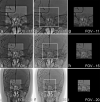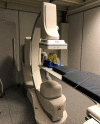SPOT REGION OF INTEREST IMAGING: A NOVEL FUNCTIONALITY AIMED AT X-RAY DOSE REDUCTION IN NEUROINTERVENTIONAL PROCEDURES
- PMID: 31950175
- PMCID: PMC7315134
- DOI: 10.1093/rpd/ncz290
SPOT REGION OF INTEREST IMAGING: A NOVEL FUNCTIONALITY AIMED AT X-RAY DOSE REDUCTION IN NEUROINTERVENTIONAL PROCEDURES
Abstract
Aim of the study: The aim of this study was to describe a new functionality aimed at X-ray dose reduction, referred to as spot region of interest (Spot ROI) and to compare it with existing dose-saving functionalities, spot fluoroscopy (Spot F), and conventional collimation (CC).
Material and methods: Dose area product, air kerma, and peak skin dose were measured for Spot ROI, Spot F, and CC in three different fields of view (FOVs) 20 × 20 cm, 15 × 15 cm, and 11 × 11 cm using an anthropomorphic head phantom RS-230T. The exposure sequence was 5 min of pulsed fluoroscopy (7.5 pulses per s) followed by 7× digital subtraction angiography (DSA) runs with 30 frames per DSA acquisition (3 fps × 10 s). The collimation in Spot F and CC was adjusted such that the size of the anatomical area exposed was as large as the Spot ROI area in each FOV.
Results: The results for all FOVs were the following: for the fluoroscopy, all measured parameters for Spot ROI and Spot F were lower than corresponding values for CC. For DSA and DSA plus fluoroscopy, all measured parameters for Spot ROI were lower than corresponding parameters for Spot F and CC.
Conclusion: Spot ROI is a promising dose-saving technology that can be applied in fluoroscopy and acquisition. The biggest benefit of Spot ROI is its ability to keep the entire FOV information always visible.
© The Author(s) 2020. Published by Oxford University Press.
Figures



References
-
- Molyneux A., Kerr R., International Subarachnoid Aneurysm Trial (ISAT) Collaborative Group, Stratton I., Sandercock P., Clarke M., Shrimpton J. and Holman R.. International subarachnoid aneurysm trial (ISAT) of neurosurgical clipping versus endovascular coiling in 2143 patients with ruptured intracranial aneurysms: a randomized trial. Lancet 360(9342), 1267–1274 (2002). - PubMed
-
- Gross B. A., Albuquerque F. C., Moon K. and McDougall C. G.. Evolution of treatment and a detailed analysis of occlusion, recurrence, and clinical outcomes in an endovascular library of 260 dural arteriovenous fistulas. J. Neurosurg. 126, 1884–1893 (2017). - PubMed
-
- Klein L. W., Miller D. L., Balter S., Laskey W., Haines D., Norbash A., Mauro M. A. and Goldstein J. A.. Occupational health hazards in the interventional laboratory: time for a safer environment. Radiology 250, 538–544 (2009). - PubMed
MeSH terms
LinkOut - more resources
Full Text Sources
Other Literature Sources
Research Materials
Miscellaneous

